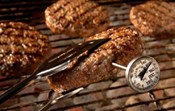To enjoy your summer, here are some checkpoints for safe grilling the next time you fire up the grill.
Shopping
✓ When shopping, choose meat and poultry last, and don’t put them in the trunk. The temperature is too hot and bacteria will grow rapidly. Make the grocery store your last stop — meat and poultry should not be out of refrigeration more than 2 hours or 1 hour in warm weather above 90°F. If meat and poultry set out too long, bacteria can produce toxins that can cause illness and stay active even during cooking.
✓ Refrigerate meat and poultry immediately upon arriving home. Always store raw meat and poultry below other foods to prevent possible cross-contamination from their dripping. Keep your refrigerator at 40°F.
✓ Purchase ground meat or poultry no more than a day or two before you plan to grill it. Otherwise, freeze them. Grill larger cuts of meat, such as steaks, within 4 days of purchase or freeze them.
Preparation
✓ Completely thaw meat and poultry in the refrigerator or just prior to cooking in a microwave. Frozen foods do not grill evenly and may be unsafe. Never thaw on the counter — bacteria will begin to grow. It takes about 24 hours to thaw 5 pounds of meat in the refrigerator.
✓ Clean up juice spills immediately so a raw product does not get on a cooked product or on foods that won’t be cooked. Juice spills should be cleaned with a paper towel or a clean dishcloth. Toss the paper towel or launder the dishcloth in hot soapy water before using it again.
✓ Marinate meat and poultry in the refrigerator. Sauce can be brushed on these foods while cooking, but never use the same sauce that has touched the raw product.
✓ Make ground beef patties about 1/2-inch thick by 4 inches in diameter (4 ounces or 4 patties per pound). This helps assure they cook thoroughly and evenly. The National Cattlemen’s Beef Association (NCBA) advises patties this size will take 11 to 13 minutes to cook to a safe temperature of 160ºF based on beef that has been removed directly from the refrigerator; cooked over medium, ash-covered coals and grilled uncovered (www.beef.org). Consult your owner’s manual for grilling guides for gas grills as brands vary greatly.
✓ Unwashed hands are a prime cause of foodborne illness. Whenever possible, wash your hands with warm, soapy water for 20 seconds before handling food. When eating away from home, pack disposable wipes for cleaning hands if no hand washing facilities are available.
Transporting
✓ Transport meat and poultry to a picnic site in a cooler kept cold with ice or frozen gel packs. Pack food and cooler immediately before leaving home. Avoid frequently opening the cooler. Pack beverages in one cooler and perishable foods in another.
✓ Keep cooler in an air-conditioned vehicle for transporting and then keep cooler in the shade or shelter at the picnic site. Remove at one time only the amount of food that will fit on the grill at one time. Keep raw meat and poultry wrapped separately from cooked foods, or foods to be eaten raw such as fruits and vegetables.
Grilling
✓ Cooking is key to meat and poultry safety. If needed, scrape the grill before grilling. Heat the grill to kill microorganisms before placing meat or poultry on it.
✓ Cook ground beef patties to 160ºF. The only way to accurately determine doneness is with a food thermometer. The color alone cannot be used to assure a hamburger has been properly cooked.
When possible, use a digital thermometer to measure the temperature of a thin food. The sensing area is only 1/2- to 1-inch long and easier to place in the center of the food.
On an “instant-read” dial thermometer, the probe must be inserted in the side of the food so the entire sensing area (usually 2–3 inches) is positioned through the center of the food.
Unless a food thermometer was used to check the temperature, do not eat a ground beef patty that is pink or red in the middle.
✓ Ground beef patties are cooked to higher temperatures because bacteria that may have been on the outside of the meat is mixed throughout. The temperature for a steak can be 145ºF for “medium rare.” A “medium” steak is cooked to 160ºF and a “well done” steak is cooked to 170ºF. Use tongs or spatula to turn steaks rather than a fork which punctures the meat and introduces bacteria into the interior of the meat.
✓ Cook poultry (whole pieces or ground patties) to 165ºF in the thigh.
✓If you’re preparing steaks, ground meat and/or poultry (which cook to different temperatures) at the same time, either use different thermometers or wash your thermometer between the different meats. Remember to clean thermometer probe in hot soapy water and hot rinse water before and after use.
✓ Adding sauces or spices to meat may make it look brown before it is done. Brush or sprinkle sauces/spices on the surface of cooked burgers.
✓ Cook meat and poultry completely at the picnic site. Partial cooking of foods ahead of time allows bacteria to survive and multiply to the point that subsequent cooking may not destroy them.
✓ Use a separate clean tongs or spatula for removing meat or poultry from the grill and place on a clean plate to avoid cross-contamination with uncooked meat.
✓ Discard any food left out for more than two hours or one hour if the temperature is above 90ºF.
When in doubt, throw it out!







